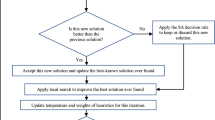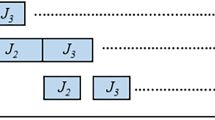Abstract
One of the basic and fundamental scheduling problems is to minimize the machine completion time vector in the \(\ell _p\) norm, a direct extension of the well-studied objective makespan (\(l_{\infty }\) norm), on parallel machines. We concentrate on the on-line and preemptive version of this problem where jobs arrive one by one over a list to be allocated to two uniform machines with job preemption permitted. We present a best possible deterministic on-line scheduling algorithm for this problem along with a matching lower bound, generalizing existing results for the identical machines scheduling problem in the literature. One notable feature of this work is the highly involved technicality compared to similar analysis in the existing literature, mainly due to the intrinsic unavailability of a closed-form formula for the competitive ratio.
Similar content being viewed by others
References
Alon, N., Azar, Y., Woeginger, G. J., & Yadid, T. (1997). Approximation schemes for scheduling. In Proceedings of the Eighth Annual ACM-SIAM Symposium on Discrete Algorithms (SODA) (pp. 493–500). ACM/SIAM.
Avidor, A., Azar, Y., & Sgall, J. (2001). Ancient and new algorithms for load balancing in the \(\ell _p\) norm. Algorithmica, 29, 422–441.
Azar, Y., & Epstein, A. (2005). Convex programming for scheduling unrelated parallel machines. In H. N. Gabow, & R. Fagin (Eds.), Proceedings of the 37th Annual ACM Symposium on Theory of Computing (STOC) (pp. 331–337).
Azar, Y., & Taub, S. (2004). All-norm approximation for scheduling on identical machines. In T. Hagerup, & J. Katajainen (Eds.), Scandinavian Workshop on Algorithm Theory (SWAT). Lecture Notes in Computer Science (Vol. 3111, pp. 298–310). Berlin: Springer.
Azar, Y., Epstein, A., & Epstein, L. (2006). Load balancing of temporary tasks in the \(\ell _p\) norm. Theoretical Computer Science, 361(2–3), 314–328.
Azar, Y., Epstein, L., Richter, Y., & Woeginger, G.J. (2002). All-norm approximation algorithms. In M. Penttonen, & M. E. Schmidt (Eds.), Scandinavian Workshop on Algorithm Theory(SWAT). Lecture Notes in Computer Science (Vol. 2368, pp. 288–297). Berlin: Springer.
Bannister, J. A., & Trivedi, K. S. (1983). Task allocation in fault-tolerant distributed systems. Acta Informatica, 20(3), 261–281.
Bansal, N., & Pruhs, K. R. (2010). Server scheduling to balance priorities, fairness and average quality of service. SIAM Journal of Computing, 39(7), 3311–3335.
Caragiannis, I. (2008). Better bounds for online load balancing on unrelated machines. In Proceedings of the Eighth Annual ACM-SIAM Symposium on Discrete Algorithms (SODA 08) (pp. 972–981).
Chandra, A. K., & Wong, C. K. (1975). Worst-case analysis of a placement algorithm related to storage allocation. SIAM Journal on Computing, 1, 249–263.
Chen, B., Du, D., Han, J., & Wen, J. (2001). On-line scheduling of small open shops. Discrete Applied Mathematics, 110, 133–150.
Cody, R. A., & Coffman, E. G. (1976). Record allocation for minimizing expected retrieval costs on drum-like storage devices. Journal of the ACM, 23(1), 103–115.
Du, D. (2004). Optimal preemptive semi-online scheduling on two uniform processors. Information Processing Letters, 92, 219–223.
Du, D., Jiang, X., & Zhang, G. (2005). Optimal preemptive online scheduling to minimize \(l_p\) norm on two processors. Journal of Manufacturing and Management Optimization, 1(3), 345–351.
Epstein, L., & Tassa, T. (2006). Optimal Preemptive Scheduling for General Target Functions. Journal of Computer and System Sciences, 72(1), 132–162.
Epstein, L., Noga, J., Seiden, S., Sgall, J., & Woeginger, G. J. (2001). Randomized online scheduling on two uniform machines. Journal of Scheduling, 4(2), 71–92.
Feigenbaum, I., & Sethuraman, J., Ye, C. (2013). Approximately optimal nechanisms for strategyproof facility location: Minimizing \(L_p\) norm of costs. arXiv:1305.2446 [cs.GT].
Feldman, M., & Wilf, Y. (2011). Randomized strategyproof mechanisms for facility location and the mini-sum-of-squares objective. CoRR, abs/1108.1762, 2011.
Golovin, D., Gupta, A., Kumar, A., Tangwongsan, K., (2007) All-norms and all-Lp-norms approximation algorithms. Computer Science Department, Carnegie Mellon University. Paper 828. http://repository.cmu.edu/compsci/828.
Kleinberg, J., Rabani, Y., & Tardos, E. (2001). Fairness in routing and load balancing. Journal of Computer and System Sciences, 63(1), 2–20.
Kumar, V. S. A., Marathe, M. V., Parthasarathy, S., & Srinivasan, A. (2005). Approximation algorithms for scheduling on multiple machines. In 46th Annual IEEE Symposium on Foundations of Computer Science (FOCS) (pp. 254–263).
Lin, L. (2007). Semi-online scheduling algorithm under the \(\ell _p\) norm on two identical machines. Journal of Zhejiang University (Science Edition), 34(2), 148–151. (In Chinese).
Lin, L., Tan, Z. Y., & He, Y. (2005). Deterministic and randomized scheduling problems under the \(\ell _p\) norm on two identical machines. Journal of Zhejiang University Science, 6(1), 20–26.
Munagala, K., Babu, S., Motwani, R., Widom, J. (2005). The pipelined set cover problem. Database Theory—ICDT 2005, 10th International Conference (pp. 83–98).
Tan, Z., He, Y., & Epstein, L. (2005). Optimal on-line algorithms for the uniform machine scheduling problem with ordinal data. Information and Computation, 196(1), 57–70.
Wen, J., & Du, D. (1998). Preemptive on-line scheduling for two uniform processors. Operations Research Letters, 23, 113–116.
Acknowledgments
Research of the first author is supported in part by the National Natural Science Foundation of China (NSFC) Grant 11001030; the Fundamental Research Funds for the Central Universities (BUPT2012RC0709). This work was done while the first author visits Faculty of Business Administration, University of New Brunswick. Research of the second author is supported by the National Science and Engineering Council of Canada (NSERC) Grant 283106.
Author information
Authors and Affiliations
Corresponding author
Appendices
Appendix 1: A proof of the lower on the optimal objective value (3)
We prove a stronger result that the equality holds in (3).
Consider the optimal (off-line) schedule opt before \(x\). Let \(L\) be the total process time before \(x\) and \(z\) be any job before \(x\) in opt. Denote \(C_{\textsc {opt}}\) to be the optimal off-line objective prior to \(x\). Note that \(\frac{z}{s}\ge \hat{s}\hat{t}L\) if and only if \(L-z\le \hat{t}L\) due to (1)–(2). Therefore, the RHS of (3)
Now we show the desired result in two cases.
-
Case 1.
\(\frac{z}{s}\ge \hat{s}\hat{t}L\), which is equivalent to \(L-z\le \hat{t}L\). From the case conditions and \(\hat{s}\ge 1\), we have that \(\frac{z}{s}\ge \hat{s}\hat{t}L\ge \hat{t}L\ge L-z\). Under these conditions, the optimal schedule is to put \(z\) entirely on machine 2 and the rest on machine 1, leading to the desired optimal value:
$$\begin{aligned}&\quad C_{\textsc {opt}}=\root p \of {(L-z)^p+\left( \frac{z}{s}\right) ^p}. \end{aligned}$$ -
Case 2.
\(\frac{z}{s}< \hat{s}\hat{t}L\), which is equivalent to \(L-z>\hat{t}L\). In this case, let \(y\) be the load assigned to machine 1 in opt. Then the objective value is \(c(y)=\root p \of {y^p+(\frac{L-y}{s})^p}\). By taking derivative, we have the stationary point \(y^*=\frac{L}{1+\hat{s}^p}=\hat{t}L\). Checking the second derivative convinces us that \(c(y)\) achieves its minimum value at \(y^*\), which, due to (1)–(2), equals to
$$\begin{aligned}&\quad \root p \of {\left( \hat{t}L\right) ^p+\left( \frac{L-\hat{t}L}{s}\right) ^p}=\root p \of {\left( \hat{s}\hat{t}L\right) ^p+\left( \hat{t}L\right) ^p}. \end{aligned}$$(13)Note that the case condition \(L-z>\hat{t}L\) implies that we can indeed assign (by preemption) the load \(y^*=\hat{t}L\) on machine 1 and the rest on machine 2 to achieve the bound in (13), implying that
$$\begin{aligned}&\quad C_{\textsc {opt}}=\root p \of {\left( \hat{s}\hat{t}L\right) ^p+\left( \hat{t}L\right) ^p}. \end{aligned}$$
Appendix 2: Competitive ratios for selected \(p\) and \(s\)
See Table 1.
Rights and permissions
About this article
Cite this article
Shuai, T., Du, D. & Jiang, X. On-line preemptive machine scheduling with \(\ell _p\) norm on two uniform machines. J Sched 18, 185–194 (2015). https://doi.org/10.1007/s10951-014-0387-8
Received:
Accepted:
Published:
Issue Date:
DOI: https://doi.org/10.1007/s10951-014-0387-8




